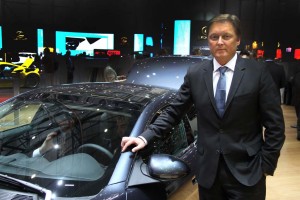
Henrik Fisker is one of several current and former Fisker Automotive execs called to testify before Congress.
Even as the company’s founder is set to testify before a House hearing, the U.S. Department of Energy has seized $21 million from Fisker Automotive to apply towards repayment of a federal loan the floundering battery-car manufacturer received.
The move appears to have emptied what was left of Fisker’s fast-dwindling cash assets, a further nudge towards bankruptcy, according to industry observers. The maker has been expected to file ever since laying off 75% of its 160-member staff earlier this month.
The collapse of Fisker is raising questions not only about a DoE loan program designed to help fund the development of advanced, high-mileage vehicles but what happened with the money Fisker tapped from its loan – as well as an estimated $1.2 billion it received from private investors.
“Given the obvious difficulties the company is facing, we are taking strong and appropriate action on behalf of taxpayers,” Aoife McCarthy, an Energy Department spokesperson said following the seizure of Fisker’s reserve account funds.
In 2009, Fisker won a $529 million low-interest loan but it was allowed to access only $192 million of that fund before the Department of Energy closed the spigot in 2011, noted McCarthy, “after the company fell short of the aggressive milestones that we had established.”
Fisker launched sales in early 2012 of its first product, the $103,000 Karma plug-in hybrid, initially attracting a number of high-profile customers including singer Justin Bieber, actor Leonardo DiCaprio, former Secretary of State Colin Powell and former Vice President Al Gore.
The maker was planning to apply the DoE loan to the development of a second model, the Fisker Atlantic. But development was repeatedly delayed, the launch pushed back from 2013 to 2014 and then postponed indefinitely as the California-based start-up began to run out of money.
Exactly how Fisker could have blown through nearly $1.5 billion in loans and private investments is a question many in the industry are trying to figure out.
“Their books are a mess,” a very well-placed source who had considered joining the firm told TheDetroitBureau.com. “It is likely going to take a forensic accounting team to understand how they could have gone through all that money” and achieved so little for it, the source complained.
Exactly what has happened to Fisker Automotive is likely to be a key topic on Wednesday when the House Oversight and Government Reform Committee holds a hearing titled, “Green Energy Oversight: Examining the Department of Energy’s Bad Bet on Fisker Automotive.”
Among those expected to testify will be the Energy Department’s senior loan officer, Nicholas Whitcombe, Fisker co-founder and COO Bernhard Kohler, Chief Executive Tony Posawatz, the former head of the Chevrolet Volt program, and Henrik Fisker, former chairman and co-founder of the company bearing his name.
Fisker resigned a month before the mass firings, citing unspecified disagreements with the rest of the maker’s senior management team. Inside sources tell TheDetroitBureau.com that the battery-carmaker’s founder wanted to slow down spending to preserve Fisker Automotive’s dwindling assets while a search for new investors or a buyer for the company moved forward.
At least two Chinese automakers were reportedly considering the purchase of the battery-car company but they backed out as Fisker’s finances continued to worsen.
That led the maker to fire the majority of its workforce a week after U.S. employees returned from a one-week, unpaid furlough. The dismissal has led to a federal lawsuit claiming Fisker violated the U.S. WARN Act, which requires a 60-day notice, except in rare conditions, ahead of mass job cuts.
Fisker Automotive claims to still be looking for new investors or a buyer. But the maker has also retained a law firm reportedly preparing a bankruptcy filing.
The DoE’s seizure of Fisker’s reserve funds is the second major setback in a matter of days. Last week, a court overseeing the bankruptcy of the maker’s battery supplier, the former A123, approved a $15 million payment to Fisker, rather than the $140 million it had originally claimed. And it is unclear if or when Fisker actually will receive any of that money.

Fisker may have had good intentions but trying to sell sand to the Arabs is a poor Biz model. To fund such foolishness with tax payer money is absurd and outrageous. Obama and the execs at the EPA should all be prosecuted for fraud and corruption, IMO.
How is Fisker building battery-powered electric cars “sell[ing] sand to the Arabs”? And since when is it “foolishness” for the government to fund basic research and development with taxpayer money? What do you think research universities do? And, absent solid evidence of either fraud or corruption, why is Obama a part of your rant?